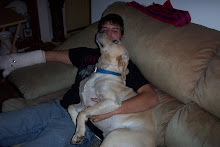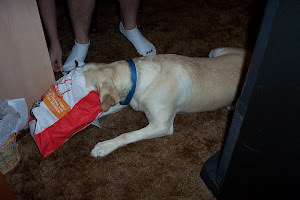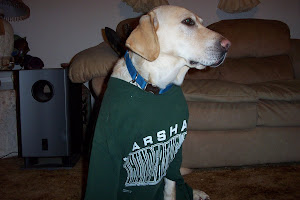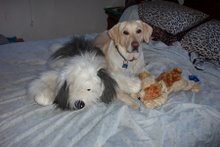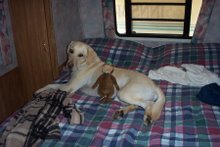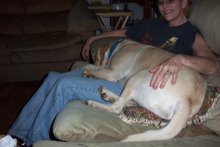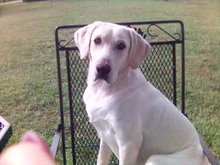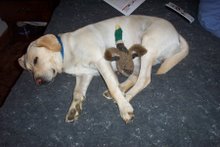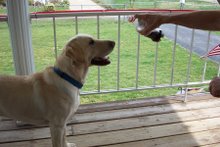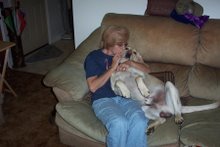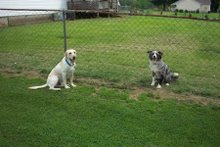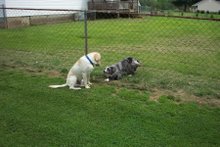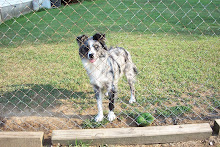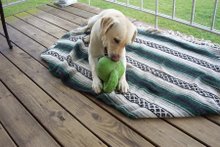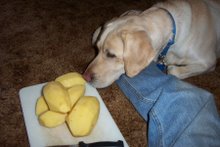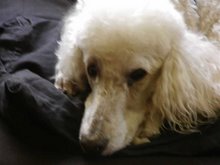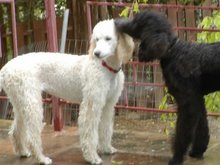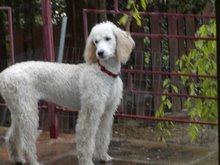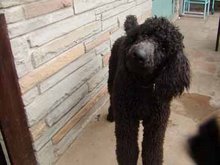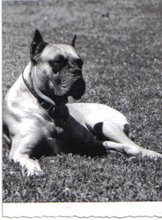The first paper you should receive from the breeder when you pick up your puppy is called the AKC Registration Application. This form is filled out by the person(s) selling you the puppy. You fill in the appropriate information and send it to the address on the application. Read this application very carefully. Here is a breakdown of the application line by line. The first section is called the Litter Information section. This should have typed, not printed, the Breed, Date of Birth, Sire or father and the Dam or the mother, the breeders name and the litter owner's name. The second section is called the Payment Information. This tell you how much it cost to register your dog and gives you a choice of getting a trace of 3 generations of your dogs family and a training video and a subscription to AKC Family Dog Magazine, or just the linage trace. And you can give your credit card info to pay for it. The next section is where you get to name your dog. On a personal note: My stepson wanted to name our dog Chance. Well, I looked at his papers and his father's name was SunnyBurkes Major General B. So I tracked down the breeder of him and asked her if I could use any part of his name for Chance. She told me I could use any part except the SunnyBurke. So, we named him Major B Chance. That is always a nice way to let people know a little bit about your dog's heritage. The next section is Permission To Use An AKC Registered Kennel Name; required if being used as part of this dog's name. Next we have where to register the sex of your dog. Next is the Check to request Limited Registration. This means that this dog is not to be used for breeding, and entry into dog events is restricted. And last on the front part of the application is the Color. Depending on the breed, you will be given choices that fit your dog and you enter the number in the boxes. It is also the to enter the markings of your dog.
Now for the back of the application.
Litter Owner Information: There are 2 boxes that the litter owner can check. They are as follows; box 1 says "I(we) still own this dog and apply for registration and have to have ownership recorded in my(our) name(s). **NOTE: Please sign on the line above your pre-printed name to complete this application. Box 2 says "I(we) transferred this dog directly to the owner listed in the New Owner(s) section below. **NOTE: Please sign on the line above your pre-printed name to certify the transfer. Under that is a statement that the breeder acknowledges by signing on the line below it, that the information appearing on this application is correct and that they are in good standing with American Kennel Club, A.K.C. With other information stated in it. The next section is the New Owner Information. The first line is the date of transfer, then the new owners name, address, city, state, zip, phone number and email address if applicable. Also, if you are co-owning the puppy with someone, the next line is for their information. Then the signature line for the new owner and co-owner if applicable. The last part is Instruction, requirements, and General Information. Read thoroughly all information before sending in your application, as any missing or wrong information will cause a long delay in getting your puppy registered with A.K.C. Any questions you have can be answered at their website, www.akc.org. Or you can call M-F 8:30am-5:00pm EST at 919-233-9767 and speak with a representative and they will be glad to help. Also you can get downloadable forms from the website.
Kallee and Tamara

A Beautiful Summer Day.
Madam Kallee, CTD, CGC - 1994-2005 - Certified Therapy Dog and a Canine Good Citizen
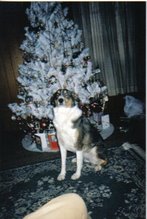
I am so pretty!
Kallee, T.D.I., CGC - Certified Therapy Dog and a Canine Good Citizen - 1994-2005

I loved to pose for the camera.
Hat Girl.

The things I do for my mom!
Happiness.

Bubby knows how to scratch a tummy.
Best of Friends.

Mine! No, Mine!, No Mine!!!
Whew !

Bubby wears me out!
This is the Life.

Just relaxing with bubby.
Kallee and Mr. Monkey
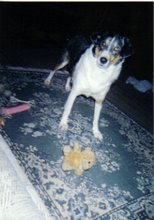
See Mr. Monkey? Wanna play?
Miss Cool.

I loved to wear my shades.
Monday, April 30, 2007
Saturday, April 28, 2007
Tidbit Corner.
So far, I have stayed with the total information aspect of a blog. But, I found some interesting tidbits from a magazine I get from my vet, Dr. Wayne Maass, owner of Guyan Animal Hospital, sends a copy of the magazine, Healthy Pet, along with a reminder when it is time to get your pet's annual shots. Really a pretty cool idea, I think. Chance thinks the world of "Doc", as I call him. I used to call my old vet, Dr. Bill Core, "doc", too. You have to have a good relationship with the person you are trusting you pet to. Well enough of that. On to the "good stuff."
Will Ferrell's dog sniffs out scripts.
We all how funny Will Ferrell is and how much delight his movies bring us, but do we know the process he goes through when choosing exactly which screenplay he wants to commit to? Perhaps he reads the screenplay, mulls it over, asks his wife for a second opinion, maybe he has a friend or agent break it down. Well, apparently, Mr. Ferrell does have a number of people read his scripts, but then he has his very own way of making the final decision. He has recently been quoted as saying, "I have my dog look at the screenplay, just kind of sniff it, and if he gives me a certain look, then I'll read it." The only problem? "Sometimes I don't know if he's giving me the look or he's just hungry."
Fast Bites: 3 Brave Pooches
Dog nabs suspected Burglar: A Sacramento police dog did his part to stop crime from rising in his hometown. This crime-fighting canine sniffed out a burglar in action, latched his teeth onto the thief's pants, and held on until backup arrived.
Dog Has His Day in Court: Henry, a black chihuahua, recently took the stand at the Third District Court in Salt Lake City. Animals are usually banned from courtrooms, but an exception was made in this case because of the abuse accusations launched against Henry's hideous owners, and scars Henry bore as proof.
Dog Thwarts Carjacker: A man who stole a car in Australia and later took refuge from the police under a bed was found and detained by a dog who didn't like the smell of the man's boots. The dog clamped down on the soul and waited for the police to show up.
A Credit Card for a Cat?
Australia has been the home of many strange and wonderful things, but this story just might be the cat's pajamas. It seems that an Australian woman, Katherine Campbell, wanted to test her bank's identity security system, so she applied for a "secondary" credit card for her cat. The Bank of Queensland not only approved the application but issued the credit card in the cat's name, Messiah. Campbell was agog: "I just couldn't believe it. People need to be aware of this, and banks need to have better security!" A spokesperson for the bank offered, "The cat's credit card has been canceled. We apologize as this should not have happened."
Barbara Walter Goes Bow Wow:
Why are so many people throwing talk show host and news veteran Barbara Walters into the soup? Well, it seems that she proclaimed in a very public way, with a very straight face, that her beloved Havanese dog, Cha-Cha, responded verbally to her words of affection by actually saying "I love you, Barbara." Okay, to make matters worse (or better, depending on whose furry sofa you sit), Barbara further asserted that she will bring on her hit TV show The View a corroborating witness who actually heard her pooch pound out those syllables.
Hemingway's Six-Toed Cats:
If you visit Key West, Florida, you can tour the residence where Ernest Hemingway wrote and found inspiration. You may also come across 50 or so six-toed cats meandering inside the house and grounds. These polydactyl(more than the normal number of toes or fingers)are all descendants of a cat the novelist received as a gift in the 1930's. Recently, USDA has stepped in, saying the cats need to be caged. But, there's no need. Hemingway made sure his cats were protected: He built high walls and provided them with an enclosed habitat where they could freely live and breed. The USDA should know better. Never go against Papa.
Will Ferrell's dog sniffs out scripts.
We all how funny Will Ferrell is and how much delight his movies bring us, but do we know the process he goes through when choosing exactly which screenplay he wants to commit to? Perhaps he reads the screenplay, mulls it over, asks his wife for a second opinion, maybe he has a friend or agent break it down. Well, apparently, Mr. Ferrell does have a number of people read his scripts, but then he has his very own way of making the final decision. He has recently been quoted as saying, "I have my dog look at the screenplay, just kind of sniff it, and if he gives me a certain look, then I'll read it." The only problem? "Sometimes I don't know if he's giving me the look or he's just hungry."
Fast Bites: 3 Brave Pooches
Dog nabs suspected Burglar: A Sacramento police dog did his part to stop crime from rising in his hometown. This crime-fighting canine sniffed out a burglar in action, latched his teeth onto the thief's pants, and held on until backup arrived.
Dog Has His Day in Court: Henry, a black chihuahua, recently took the stand at the Third District Court in Salt Lake City. Animals are usually banned from courtrooms, but an exception was made in this case because of the abuse accusations launched against Henry's hideous owners, and scars Henry bore as proof.
Dog Thwarts Carjacker: A man who stole a car in Australia and later took refuge from the police under a bed was found and detained by a dog who didn't like the smell of the man's boots. The dog clamped down on the soul and waited for the police to show up.
A Credit Card for a Cat?
Australia has been the home of many strange and wonderful things, but this story just might be the cat's pajamas. It seems that an Australian woman, Katherine Campbell, wanted to test her bank's identity security system, so she applied for a "secondary" credit card for her cat. The Bank of Queensland not only approved the application but issued the credit card in the cat's name, Messiah. Campbell was agog: "I just couldn't believe it. People need to be aware of this, and banks need to have better security!" A spokesperson for the bank offered, "The cat's credit card has been canceled. We apologize as this should not have happened."
Barbara Walter Goes Bow Wow:
Why are so many people throwing talk show host and news veteran Barbara Walters into the soup? Well, it seems that she proclaimed in a very public way, with a very straight face, that her beloved Havanese dog, Cha-Cha, responded verbally to her words of affection by actually saying "I love you, Barbara." Okay, to make matters worse (or better, depending on whose furry sofa you sit), Barbara further asserted that she will bring on her hit TV show The View a corroborating witness who actually heard her pooch pound out those syllables.
Hemingway's Six-Toed Cats:
If you visit Key West, Florida, you can tour the residence where Ernest Hemingway wrote and found inspiration. You may also come across 50 or so six-toed cats meandering inside the house and grounds. These polydactyl(more than the normal number of toes or fingers)are all descendants of a cat the novelist received as a gift in the 1930's. Recently, USDA has stepped in, saying the cats need to be caged. But, there's no need. Hemingway made sure his cats were protected: He built high walls and provided them with an enclosed habitat where they could freely live and breed. The USDA should know better. Never go against Papa.
Toxic Plants
Aloe
- Amaryllis
- Andromeda Japonica
- Asian Lily (Liliaceae)
- Asparagus Fern
- Australian Nut
- Autumn Crocus
- Avocado
- Azalea
B
- Bird of Paradise
- American Bittersweet
- European Bittersweet
- Branching Ivy
- Buckeye
- Buddist Pine
C
- Caladium
- Calla Lily
- Castor Bean
- Ceriman (aka Cutleaf Philodendron)
- Charming
Diffenbachia
- Chinaberry Tree
- Chinese Evergreen
- Christmas Rose
- Clematis
- Cordatum
- Corn Plant (aka Cornstalk Plant)
- Cornstalk Plant (aka Corn Plant)
- Cutleaf Philodendron (aka Ceriman)
- Cycads
- Cyclamen
D
- Daffodil
- Day Lily
- Devil's Ivy
- Dumb Cane
- Deadly Nightshade (See Nightshade)
E
- Easter Lily
- Elephant Ears
- Emerald Feather (aka Emerald Fern)
- Emerald Fern (aka Emerald Feather)
- English Ivy
F
- Fiddle-Leaf Philodendron
- Flamingo Plant
- Florida Beauty
- Foxglove
- Fruit Salad Plant
G
- Glacier Ivy
- Gladiolas
- Glory Lily
- Gold Dieffenbachia
- Gold Dust Dracaena
- Golden Pothos
- Green Gold Nephthysis
H
- Hahn's self branching English Ivy
- Heartleaf Philodendron
- Heavenly Bamboo
- Holly
- Horsehead Philodendron
- Hurricane Plant
- Hyacinth
- Hydrangea
I
- Iris
J
- Japanese Show Lily
- Japanese Yew (aka Yew)
- Jerusalem Cherry
Back to Top
K
- Kalanchoe
L
- Lace Fern
- Lacy Tree
- Lily of the Valley
M
- Macadamia Nut
- Madagascar Dragon Tree
- Marble Queen
- Marijuana
- Mauna Loa Peace Lily (aka Peace Lily)
- Mexican Breadfruit
- Mistletoe "American"
- Morning Glory
- Mother-in-Law
N
- Narcissus
- Needlepoint Ivy
- Nephthytis
- Nightshade
O
- Oleander
- Onion
- Orange Day Lily
P
- Panda
- Peace Lily (aka Mauna Loa Peace Lily)
- Philodendron Pertusum
- Plumosa Fern
- Precatory Bean
Q
- Queensland Nut
R
- Red Emerald
- Red Lily
- Red-Margined Dracaena (aka Straight-Margined Dracaena)
- Red Princess
- Rhododendron
- Ribbon Plant (Dracaena sanderiana)
- Rubrum Lily
S
- Saddle Leaf Philodendron
- Sago Palm
- Satin Pothos
- Schefflera
- Spotted Dumb Cane
- Stargazer Lily
- Striped Dracaena
- Sweetheart Ivy
- Swiss Cheese Plant
T
- Taro Vine
- Tiger Lily
- Tomato Plant
- Tree Philodendron
- Tropic Snow Dumbcane
- Tulip
V
- Variable Dieffenbachia
- Variegated Philodendron
W
- Warneckei Dracaena
- Wood Lily
Y
- Yesterday, Today, Tomorrow
- Yew (aka Japanese Yew)
- Yucca
source: www.aspca.com
- Amaryllis
- Andromeda Japonica
- Asian Lily (Liliaceae)
- Asparagus Fern
- Australian Nut
- Autumn Crocus
- Avocado
- Azalea
B
- Bird of Paradise
- American Bittersweet
- European Bittersweet
- Branching Ivy
- Buckeye
- Buddist Pine
C
- Caladium
- Calla Lily
- Castor Bean
- Ceriman (aka Cutleaf Philodendron)
- Charming
Diffenbachia
- Chinaberry Tree
- Chinese Evergreen
- Christmas Rose
- Clematis
- Cordatum
- Corn Plant (aka Cornstalk Plant)
- Cornstalk Plant (aka Corn Plant)
- Cutleaf Philodendron (aka Ceriman)
- Cycads
- Cyclamen
D
- Daffodil
- Day Lily
- Devil's Ivy
- Dumb Cane
- Deadly Nightshade (See Nightshade)
E
- Easter Lily
- Elephant Ears
- Emerald Feather (aka Emerald Fern)
- Emerald Fern (aka Emerald Feather)
- English Ivy
F
- Fiddle-Leaf Philodendron
- Flamingo Plant
- Florida Beauty
- Foxglove
- Fruit Salad Plant
G
- Glacier Ivy
- Gladiolas
- Glory Lily
- Gold Dieffenbachia
- Gold Dust Dracaena
- Golden Pothos
- Green Gold Nephthysis
H
- Hahn's self branching English Ivy
- Heartleaf Philodendron
- Heavenly Bamboo
- Holly
- Horsehead Philodendron
- Hurricane Plant
- Hyacinth
- Hydrangea
I
- Iris
J
- Japanese Show Lily
- Japanese Yew (aka Yew)
- Jerusalem Cherry
Back to Top
K
- Kalanchoe
L
- Lace Fern
- Lacy Tree
- Lily of the Valley
M
- Macadamia Nut
- Madagascar Dragon Tree
- Marble Queen
- Marijuana
- Mauna Loa Peace Lily (aka Peace Lily)
- Mexican Breadfruit
- Mistletoe "American"
- Morning Glory
- Mother-in-Law
N
- Narcissus
- Needlepoint Ivy
- Nephthytis
- Nightshade
O
- Oleander
- Onion
- Orange Day Lily
P
- Panda
- Peace Lily (aka Mauna Loa Peace Lily)
- Philodendron Pertusum
- Plumosa Fern
- Precatory Bean
Q
- Queensland Nut
R
- Red Emerald
- Red Lily
- Red-Margined Dracaena (aka Straight-Margined Dracaena)
- Red Princess
- Rhododendron
- Ribbon Plant (Dracaena sanderiana)
- Rubrum Lily
S
- Saddle Leaf Philodendron
- Sago Palm
- Satin Pothos
- Schefflera
- Spotted Dumb Cane
- Stargazer Lily
- Striped Dracaena
- Sweetheart Ivy
- Swiss Cheese Plant
T
- Taro Vine
- Tiger Lily
- Tomato Plant
- Tree Philodendron
- Tropic Snow Dumbcane
- Tulip
V
- Variable Dieffenbachia
- Variegated Philodendron
W
- Warneckei Dracaena
- Wood Lily
Y
- Yesterday, Today, Tomorrow
- Yew (aka Japanese Yew)
- Yucca
source: www.aspca.com
Thursday, April 26, 2007
Rimadyl and Arthritis
Dog Owner Information About Rimadyl® (carprofen)
Rimadyl® (pronounced "Rim-a-dill") for Osteoarthritis and Post-Surgical Pain
Generic name: carprofen ("car-pro-fen")
This summary contains important information about Rimadyl. You should read this information before you start giving your dog Rimadyl and review it each time the prescription is refilled. This sheet is provided only as a summary and does not take the place of instructions from your veterinarian. Talk to your veterinarian if you do not understand any of this information or if you want to know more about Rimadyl.
What is Rimadyl?
Rimadyl is a non-steroidal anti-inflammatory drug (NSAID) that is used to reduce pain and inflammation (soreness) due to osteoarthritis and pain following surgery in dogs. Rimadyl is a prescription drug for dogs. It is available as a caplet and chewable tablet and is given to dogs by mouth, or in an injectable formula administered by veterinarians.
Osteoarthritis (OA) is a painful condition caused by "wear and tear" of cartilage and other parts of the joints that may result in the following changes or signs in your dog:
Limping or lameness
Decreased activity or exercise (reluctance to stand, climb stairs, jump or run, or difficulty in performing these activities)
Stiffness or decreased movement of joints
Surgical pain (e.g., for surgeries such as spays, ear procedures or orthopedic repairs) can be controlled when your veterinarian administers Rimadyl before the procedure. Then, your veterinarian may prescribe Rimadyl treatment for your dog for several days after going home.
What kind of results can I expect when my dog is on Rimadyl for OA?
While Rimadyl is not a cure for osteoarthritis, it can relieve the pain and inflammation of OA and improve your dog’s mobility.
Response varies from dog to dog but can be quite dramatic.
In most dogs, improvement can be seen in a matter of days.
If Rimadyl is discontinued or not given as directed, your dog's pain and inflammation may come back.
Who should not take Rimadyl?
Your dog should not be given Rimadyl if he/she:
Has had an allergic reaction to carprofen, the active ingredient of Rimadyl.
Has had an allergic reaction to aspirin or other NSAIDs (for example etodolac or phenylbutazone) such as hives, facial swelling, or red or itchy skin.
Rimadyl should be given to dogs only.
Cats should not be given Rimadyl. Call your veterinarian immediately if your cat receives Rimadyl. People should not take Rimadyl. Keep Rimadyl and all medicines out of reach of children. Call your physician immediately if you accidentally take Rimadyl.
How to give Rimadyl to your dog.
Rimadyl should be given according to your veterinarian’s instructions. Your veterinarian will tell you what amount of Rimadyl is right for your dog and for how long it should be given. Rimadyl should be given by mouth and may be given with or without food.
What to tell/ask your veterinarian before giving Rimadyl.
Talk to your veterinarian about:
What tests might be done before Rimadyl is prescribed?
How often your dog may need to be examined by your veterinarian.
The risks and benefits of using Rimadyl.
If your dog is prescribed Rimadyl for osteoarthritis, ask your vet about:
The signs of OA you have observed (for example limping, stiffness).
The importance of weight control and exercise in the management of OA.
Tell your veterinarian if your dog has ever had the following medical problems:
Experienced side effects from Rimadyl or other NSAIDs, such as aspirin
Digestive upset (vomiting and/or diarrhea)
Liver disease
Kidney disease
A bleeding disorder (for example, Von Willebrand’s disease)
Tell your veterinarian about:
Any other medical problems or allergies that your dog has now or has had.
All medicines that you are giving your dog or plan to give your dog, including those you can get without a prescription.
If your dog is pregnant, nursing or if you plan to breed your dog.
What are the possible side effects that may occur in my dog during Rimadyl therapy?
Rimadyl, like other drugs, may cause some side effects. Serious but rare side effects have been reported in dogs taking NSAIDs, including Rimadyl. Serious side effects can occur with or without warning, and in rare situations result in death.
The most common NSAID-related side effects generally involve the stomach (such as bleeding ulcers), and liver or kidney problems. Look for the following side effects that can indicate your dog may be having a problem with Rimadyl or may have another medical problem:
Decrease or increase in appetite
Vomiting
Change in bowel movements (such as diarrhea, or black, tarry or bloody stools)
Change in behavior (such as decreased or increased activity level, incoordination, seizure or aggression)
Yellowing of gums, skin, or whites of the eyes (jaundice)
Change in drinking habits (frequency, amount consumed)
Change in urination habits (frequency, color, or smell)
Change in skin (redness, scabs, or scratching)
It is important to stop therapy and contact your veterinarian immediately if you think your dog has a medical problem or side effect from Rimadyl therapy. If you have additional questions about possible side effects, talk to your veterinarian.
Can Rimadyl be given with other medicines?
Rimadyl should not be given with other NSAIDs (for example, aspirin, etodolac, deracoxib, meloxicam, tepoxalin) or steroids (for example, cortisone, prednisone, dexamethasone, triamcinolone).
Tell your veterinarian about all medicines you have given your dog in the past, and any medicines that you are planning to give with Rimadyl. This should include other medicines that you can get without a prescription. Your veterinarian may want to check that all of your dog's medicines can be given together.
What do I do in case my dog eats more than the prescribed amount of Rimadyl?
Contact your veterinarian immediately if your dog eats more than the prescribed amount of Rimadyl.
source: www.rimadyl.com
Rimadyl® (pronounced "Rim-a-dill") for Osteoarthritis and Post-Surgical Pain
Generic name: carprofen ("car-pro-fen")
This summary contains important information about Rimadyl. You should read this information before you start giving your dog Rimadyl and review it each time the prescription is refilled. This sheet is provided only as a summary and does not take the place of instructions from your veterinarian. Talk to your veterinarian if you do not understand any of this information or if you want to know more about Rimadyl.
What is Rimadyl?
Rimadyl is a non-steroidal anti-inflammatory drug (NSAID) that is used to reduce pain and inflammation (soreness) due to osteoarthritis and pain following surgery in dogs. Rimadyl is a prescription drug for dogs. It is available as a caplet and chewable tablet and is given to dogs by mouth, or in an injectable formula administered by veterinarians.
Osteoarthritis (OA) is a painful condition caused by "wear and tear" of cartilage and other parts of the joints that may result in the following changes or signs in your dog:
Limping or lameness
Decreased activity or exercise (reluctance to stand, climb stairs, jump or run, or difficulty in performing these activities)
Stiffness or decreased movement of joints
Surgical pain (e.g., for surgeries such as spays, ear procedures or orthopedic repairs) can be controlled when your veterinarian administers Rimadyl before the procedure. Then, your veterinarian may prescribe Rimadyl treatment for your dog for several days after going home.
What kind of results can I expect when my dog is on Rimadyl for OA?
While Rimadyl is not a cure for osteoarthritis, it can relieve the pain and inflammation of OA and improve your dog’s mobility.
Response varies from dog to dog but can be quite dramatic.
In most dogs, improvement can be seen in a matter of days.
If Rimadyl is discontinued or not given as directed, your dog's pain and inflammation may come back.
Who should not take Rimadyl?
Your dog should not be given Rimadyl if he/she:
Has had an allergic reaction to carprofen, the active ingredient of Rimadyl.
Has had an allergic reaction to aspirin or other NSAIDs (for example etodolac or phenylbutazone) such as hives, facial swelling, or red or itchy skin.
Rimadyl should be given to dogs only.
Cats should not be given Rimadyl. Call your veterinarian immediately if your cat receives Rimadyl. People should not take Rimadyl. Keep Rimadyl and all medicines out of reach of children. Call your physician immediately if you accidentally take Rimadyl.
How to give Rimadyl to your dog.
Rimadyl should be given according to your veterinarian’s instructions. Your veterinarian will tell you what amount of Rimadyl is right for your dog and for how long it should be given. Rimadyl should be given by mouth and may be given with or without food.
What to tell/ask your veterinarian before giving Rimadyl.
Talk to your veterinarian about:
What tests might be done before Rimadyl is prescribed?
How often your dog may need to be examined by your veterinarian.
The risks and benefits of using Rimadyl.
If your dog is prescribed Rimadyl for osteoarthritis, ask your vet about:
The signs of OA you have observed (for example limping, stiffness).
The importance of weight control and exercise in the management of OA.
Tell your veterinarian if your dog has ever had the following medical problems:
Experienced side effects from Rimadyl or other NSAIDs, such as aspirin
Digestive upset (vomiting and/or diarrhea)
Liver disease
Kidney disease
A bleeding disorder (for example, Von Willebrand’s disease)
Tell your veterinarian about:
Any other medical problems or allergies that your dog has now or has had.
All medicines that you are giving your dog or plan to give your dog, including those you can get without a prescription.
If your dog is pregnant, nursing or if you plan to breed your dog.
What are the possible side effects that may occur in my dog during Rimadyl therapy?
Rimadyl, like other drugs, may cause some side effects. Serious but rare side effects have been reported in dogs taking NSAIDs, including Rimadyl. Serious side effects can occur with or without warning, and in rare situations result in death.
The most common NSAID-related side effects generally involve the stomach (such as bleeding ulcers), and liver or kidney problems. Look for the following side effects that can indicate your dog may be having a problem with Rimadyl or may have another medical problem:
Decrease or increase in appetite
Vomiting
Change in bowel movements (such as diarrhea, or black, tarry or bloody stools)
Change in behavior (such as decreased or increased activity level, incoordination, seizure or aggression)
Yellowing of gums, skin, or whites of the eyes (jaundice)
Change in drinking habits (frequency, amount consumed)
Change in urination habits (frequency, color, or smell)
Change in skin (redness, scabs, or scratching)
It is important to stop therapy and contact your veterinarian immediately if you think your dog has a medical problem or side effect from Rimadyl therapy. If you have additional questions about possible side effects, talk to your veterinarian.
Can Rimadyl be given with other medicines?
Rimadyl should not be given with other NSAIDs (for example, aspirin, etodolac, deracoxib, meloxicam, tepoxalin) or steroids (for example, cortisone, prednisone, dexamethasone, triamcinolone).
Tell your veterinarian about all medicines you have given your dog in the past, and any medicines that you are planning to give with Rimadyl. This should include other medicines that you can get without a prescription. Your veterinarian may want to check that all of your dog's medicines can be given together.
What do I do in case my dog eats more than the prescribed amount of Rimadyl?
Contact your veterinarian immediately if your dog eats more than the prescribed amount of Rimadyl.
source: www.rimadyl.com
Saturday, April 21, 2007
Huntington Kennel Club Dog Show.
The Huntington Kennel Club will be holding it's summer show at the Memorial Field House, 5th Avenue, Huntington, WV, on July 7th and 8th. Mrs. Maxine Beam will be one of the guest judges, and will be judging the Best in Show. Come out to this great event and see all the various breeds of dogs. Each year, the participation in the show has grown by leaps and bounds. Mr. Tim Childers is the show chairman and can be reached at his business, Timbral Pet Services, Rt. 60 E., Barboursville, WV 25504.....304-736-1747, which is a full service boarding, training and grooming facility, if you have any questions about the show or you can go to their website at www.huntingtonkennelclub.org.
Thursday, April 19, 2007
Pet Food Recall website.
Here is the website to check out any new additions to the pet food recall. http://www.menufoods.com Here is another ASPCA website that gives pet food recall information in real time......www.avma.org/aa/menufoodsrecall/products.asp
Saturday, April 14, 2007
Purina Adoption Program.
Purina Pets for People Program
Since 1984, the Purina Pets For People Program has provided life-enriching benefits of pet ownership to Americans. Since its inception, the Purina Pets For People Program has donated more than $16 million dollars to participating humane shelters and matched thousands of shelter pets with owners.
SENIOR ADOPTION PROGRAM
The Senior Adoption Program provides the opportunity for senior citizens, aged 60 years and older, to adopt a pet for little or no cost. The program helps to reimburse shelters for the cost of spaying or neutering, vaccinations, and additional adoption fees. Nearly 300 shelters are involved in this particular program nationally.
ADOPTION KIT PROGRAM
The Adoption Kit Program distributes nearly 200,000 starter kits through approximately 200 shelters nationwide. The kits include important information on caring for a new pet, feeding recommendations based upon lifestage, a special issue of Pet Life magazine, a high value coupon for Purina brand pet foods and the opportunity to request special offers to help care for your pet.
VERY BEST PET NETWORK
The Very Best Pet Network is a partnership between Purina, the American Humane Association and Wal*Mart to connect shelter animals with new families. Participating shelters are paired with a Wal*Mart store, where the shelter will post pictures of adoptable pets. Participating shelters are also eligible to receive a grant to help fund their programs.
For the location of a participating shelter in your area, you can contact us online or call 1-800-7PURINA (Weekdays, 9 a.m.—4 p.m. CT).
If you are with a shelter interested in learning more about these programs, please contact us at purinapetsforpeople@mbsassoc.com or toll-free at 1-888-737-9841 (weekdays, 9 a.m.- 4 p.m. CT).
Information found at: http://www.purina.com/science/programs/PetsForPeople.aspx
Since 1984, the Purina Pets For People Program has provided life-enriching benefits of pet ownership to Americans. Since its inception, the Purina Pets For People Program has donated more than $16 million dollars to participating humane shelters and matched thousands of shelter pets with owners.
SENIOR ADOPTION PROGRAM
The Senior Adoption Program provides the opportunity for senior citizens, aged 60 years and older, to adopt a pet for little or no cost. The program helps to reimburse shelters for the cost of spaying or neutering, vaccinations, and additional adoption fees. Nearly 300 shelters are involved in this particular program nationally.
ADOPTION KIT PROGRAM
The Adoption Kit Program distributes nearly 200,000 starter kits through approximately 200 shelters nationwide. The kits include important information on caring for a new pet, feeding recommendations based upon lifestage, a special issue of Pet Life magazine, a high value coupon for Purina brand pet foods and the opportunity to request special offers to help care for your pet.
VERY BEST PET NETWORK
The Very Best Pet Network is a partnership between Purina, the American Humane Association and Wal*Mart to connect shelter animals with new families. Participating shelters are paired with a Wal*Mart store, where the shelter will post pictures of adoptable pets. Participating shelters are also eligible to receive a grant to help fund their programs.
For the location of a participating shelter in your area, you can contact us online or call 1-800-7PURINA (Weekdays, 9 a.m.—4 p.m. CT).
If you are with a shelter interested in learning more about these programs, please contact us at purinapetsforpeople@mbsassoc.com or toll-free at 1-888-737-9841 (weekdays, 9 a.m.- 4 p.m. CT).
Information found at: http://www.purina.com/science/programs/PetsForPeople.aspx
Subscribe to:
Posts (Atom)



